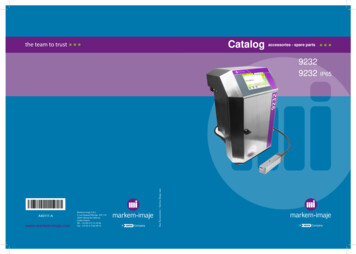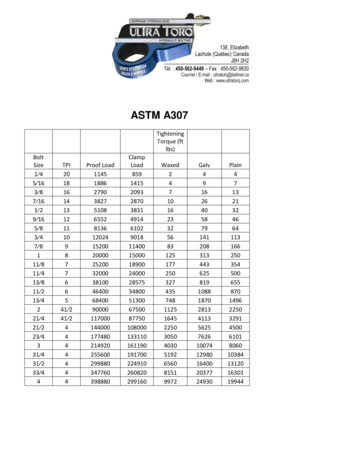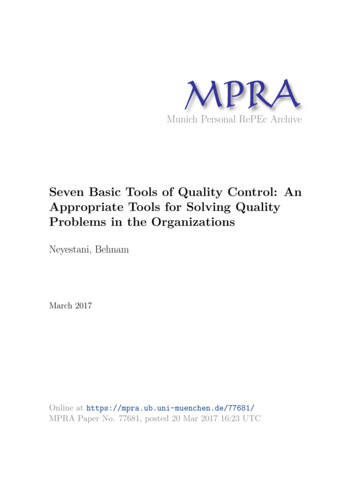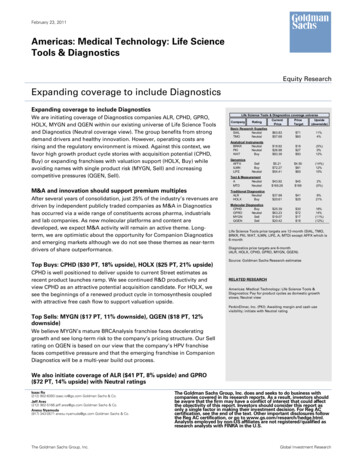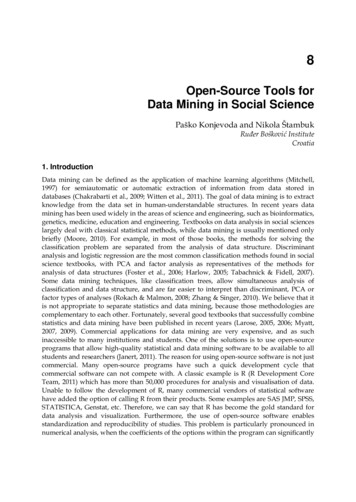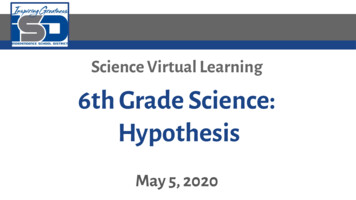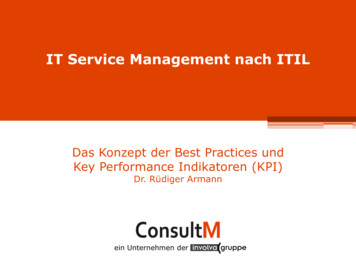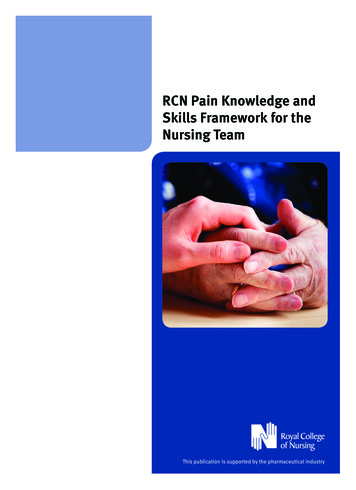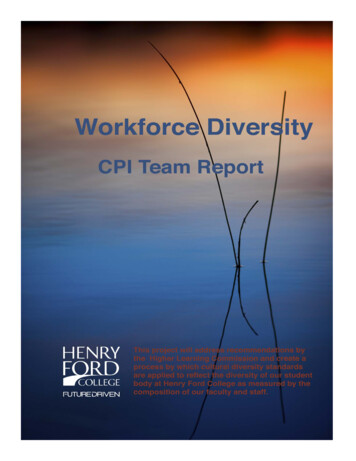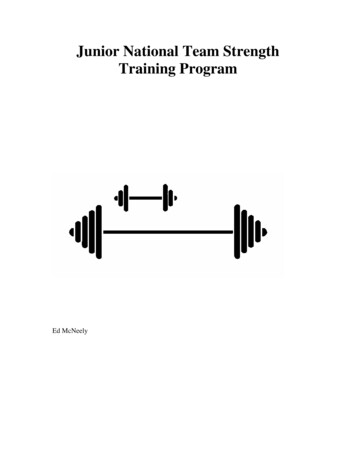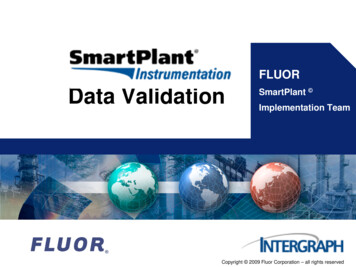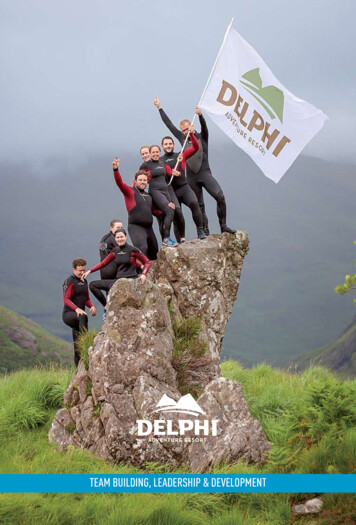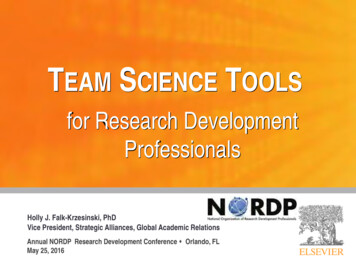
Transcription
TEAM SCIENCE TOOLSfor Research DevelopmentProfessionalsHolly J. Falk-Krzesinski, PhDVice President, Strategic Alliances, Global Academic RelationsAnnual NORDP Research Development Conference Orlando, FLMay 25, 2016
INTRODUCTION"Team research, especially interdisciplinary research,is characterized by synergies among experts thatcan transform both scholars and scholarship“–3John Cacioppo, PhD, the Tiffany and Margaret Blake DistinguishedService Professor in Psychology, The University of Chicago, from theArete Initiative website http://arete.uchicago.edu/ (2010)
Brief Bio Industry/Research Information/Publishing (3 yrs) Academia/Non-professoriate (20 yrs) Anti-infective research, Abbott LaboratoriesNonprofit (7 yrs) 4Adjunct Lecturer, School of Professional Studies, Philanthropy & NonprofitProgram, Northwestern UniversityDirector, Office of Research DevelopmentSenior Lecturer and Research Assistant Professor, Northwestern UniversityAssistant Chair, Biology and Associate Director, STEM PhD programUndergrad, PhD, Postdoc trainingIndustry/Pharma (2.5 yrs) Vice President, Strategic Alliances, Global Academic Relations, ElsevierEditor-in-Chief, AWIS MagazineFounding President, National Organization of Research DevelopmentProfessionals (NORDP)!!!!
Team Science Experience Connecting researchers and resources in pursuit of largecollaborative projectsCompiled a 1.9K reference Team Science resource libraryPublished primary research findings that inform effectivecollaboration, especially for science teamsDeveloped and taught one of the first-ever Team Sciencegraduate courses, co-developed an online Team SciencecourseChaired the Science of Team Science Conference for its first 3yearsTeam science consultant for almost two dozen US universitiesInvolved with the US, UK, and Canadian national team scienceinitiatives66
What is Team oration7
Cross-disciplinarity (Uni)Disciplinary researchThree Cross-disciplinary research orientations Combine or integrate from more than one field Multidisciplinary Joint, Interactive, PartnershipDialogue, Hybridization, ComplementaryTransdisciplinary 8Independent, Sequential, DivisionalExchangeInterdisciplinary Concepts, Methods, and TheoriesIntegrative, Interdependence, EmergenceReciprocity, Discourse, Share Vocabulary, ExtendsFigures are from a licensed clip art library
NIH Defines Interdisciplinary Research “Interdisciplinary research (IR) integrates theanalytical strengths of two or more oftendisparate scientific disciplines to create anew hybrid discipline. Traditional gaps interminology, approach, and methodologymight be eliminated.” logyNIHRoadmap.nih.gov/interdisciplinary
NAS/NSF Define Interdisciplinary Research Interdisciplinary research (IDR) is amode of research by teams orindividuals that integrates information,data, techniques, tools, perspectives,concepts, and/or theories from two ormore disciplines or bodies ofspecialized knowledge to advancefundamental understanding or to solveproblems whose solutions are beyondthe scope of a single discipline or areaof research practice.10
Collaboration11Frey, B.B., Lohmeier, J.H., Lee, S.W., and Tollefson, N. (2006). Measuring collaboration among grant partners. Am. J. Eval. 27, 383–392.
Team Science Initiatives 12Large research, training, and translationalprogramsFunded by universities/research institutions,federal agencies and foundationsCollaborative and interdisciplinary scientificapproachesExtended multi-dimensionalscopeStokols, D. (2006). Toward a Science of Transdisciplinary Action Research. American Journal of Community Psychology 38, 63-77.
Science Facilitated by Team Science Outcome-oriented investigations Urgent and ComplexShared 13Problem/project/product-oriented research vs. knowledge-producing scienceShared Goal between investigators from different disciplines/withdifferent expertiseShared Approach through a common facility, instrumentationShared Data Set accessIntractability: Successive efforts not able to make progressGrand Challenge: Intellectual challenge and potential highpayoffComplementary to *not mutually exclusive of* individualinvestigator-driven research
Evidence Informing Practice Increasingly difficult to make scientific discoveries More people required to find out new things Research increasingly done in teams, for virtually all fields Teams typically produce more highly cited research than individuals 14Teams that are more diverse are even more highly impactfulTeams are more likely than solo authors to insert novel combinations of science intofamiliar knowledge domains; Papers of this type are twice as likely to be highly-cited works More team science is done inter-institutionally Virtual communities produce higher impact work International collaboration shows a further boost in citation impact But, dispersed teams have a high rate of failure Women scientists who do not collaborate are less productive A likelihood for researchers to publish more papers earlier in their careers
Translating Science to Practice 15There is an increased demand for team scienceinitiatives in academia and by external fundingagenciesCoordination costs mean that team science takesmore time, at least proximally; distal payoff in termsof accelerationImperative that we understand the most effectivepractices for productive cross-disciplinarycollaboration and team scienceThen train individual investigators, institutionalleaders, and funders to employ them
Elsevier’s Academic Executive -2-issue-2-201216
Toolbox ProjectThe Toolbox Project1,2 Collaborative Communication Workshop provides a philosophicalyet practical enhancement to cross-disciplinary, collaborative science. Rooted inphilosophical analysis, the Toolbox workshop enables investigators, researchdevelopment professionals, project managers, and collaborators to engage in astructured dialogue about their research assumptions and cross-disciplinarycollaboration. This yields both self-awareness and mutual understanding, supplyingindividuals with the robust foundation needed for effective collaborativeresearch. Led by Toolbox Project Facilitators, Workshop participants will engage insmall group discussion and share respective views in response to a number ofprobing statements about science motivation, methodology, confirmation, objectivity,values, and reductionism.1Eigenbrode,18S.D., O'Rourke, M., Wulfhorst, J.D., Althoff, D.M., Goldberg, C.S., Merrill, K., Morse, W., Nielsen-Pincus, M.A.X.,Stephens, J., Winowiecki, L., et al. (2007). Employing Philosophical Dialogue in Collaborative Science. Bioscience 57, 55-64.2Crowley, S., Eigenbrode, S.D., O’Rourke, M., and Wulfhorst, J.D. (2010). Cross-disciplinary localization: A philosophicalapproach. MultiLingual, September, 1-4.
Toolbox Questionnaire19
Collaboration Readiness On-line diagnostic survey for geographicallydistributed collaborations. The survey probesfactors that may strengthen or weaken thecollaboration. The Wizard provides both personaland project-level reports to help build successfuland productive collaborative 0
A Field Guide/Partner Agreement Overall Goals & VisionWho Will Do WhatSharing/StoringReagents & DataAuthorship, CreditContingencies &CommunicatingConflict of Interesthttp://teamscience.nih.gov21See also Bennett, L.M., and Gadlin, H. (2012). Collaboration and TeamScience: From Theory to Practice. J Invest Med 60, 768-775
Team Science Toolkit22www.teamsciencetoolkit.cancer.gov
SciTS Listserv The Science of Team Science (SciTS) listserv facilitates conversation amongindividuals who are engaged in, studying, or managing team science, in the USand internationally. The listserv is maintained collaboratively by the SciTS Teamat the National Cancer Institute, Division of Cancer Control and PopulationSciences, Behavioral Research eteam) at the NIH. 23TO SUBSCRIBE: Send an email with a blank subject line to: listserv@list.nih.gov. The message body shouldread: subscribe SciTSlist [your full name]. Please do not include the brackets. For example, for Robin Smith tosubscribe, the message would read: subscribe SciTSlist Robin Smith. You will receive a confirmation email.TO POST TO THE LISTSERV: Send an email to SciTSlist@list.nih.gov. Any subscriber may post to the list.TO VIEW THE ARCHIVES: To view the archives of all previous postings, go to:http://list.nih.gov/archives/SciTSlist.htmlTO RECEIVE MESSAGES IN A DAILY DIGEST: The default setting sends you each message as it is postedto the listserv. To receive one daily digest, instead, go to:http://list.nih.gov/cgi-bin/wa.exe?SUBED1 SciTSlist&A 1 and select “digest” as your subscription type.TECHNICAL PROBLEMS WITH YOUR SUBSCRIPTION? Contact the list administrator, Judy Kuan, at:kuanj@mail.nih.gov. Please be sure to state that your email is in reference to the SciTS listserv.
Levels of Collaboration Survey Measuring Collaboration Among Grant Partners– Evaluate collaboration and communication– Levels of Collaboration Scale– Visually display results of collaborationFrey, B.B., Lohmeier, J.H., Lee, S.W., and Tollefson, N. (2006). Measuringcollaboration among grant partners. American Journal of Evaluation 27, 383-392.28
Visualize Collaborative Relationships29Frey, B.B., Lohmeier, J.H., Lee, S.W., and Tollefson, N. (2006). Measuring collaboration among grant partners. American Journal of Evaluation 27, 383-392.
Funding for Team ScienceComparing (cumulative) number of publications of TD initiativewith matched R01 projects from the tobacco field over 10-year period500Cumulative Publications - All450400350300250TTURC200R01 stacked150R01 long100500123456Project Year78910Centers initial lag in number of publications is eliminated aroundProject Year 4.30Hall, K.L., Stokols, D., Stipelman, B.A., Vogel, A.L., Feng, A., Masimore, B., Morgan, G., Moser, R.P., Marcus, S.E., and Berrigan, D. (2012). Assessing the Value of Team Science: A StudyComparing Center- and Investigator-Initiated Grants. American Journal of Preventive Medicine 42, 157-163.
Teams, Innovativeness and Impact 31Highest impact science is grounded inconventional combinations of prior work,combined with novel combinationsPapers of this type were twice as likely tobe highly-cited worksTeams are 37.7% more likely than soloauthors to insert novel combinations intofamiliar knowledge domainsBrian Uzzi, et al. Atypical Combinations and Scientific Impact. Science 342, 468 (2013)
Know Your Network32
Trust in the Team 33Face-to-face interaction in the team isessentialHigh-tech (aka “lean”) communication,such as email and videoconferencing,strips away personal interaction needed tobreed trustTeams need to be able to get togetherinitially to build trust, and periodically to“recharge” trustRockmann, K.W., and Northcraft, G.B. (2008). To be or not to be trusted: The influence of media richness on defection and deception. OrganizationalBehavior and Human Decision Processes 107, 106–122.
National Academies Consensus Report34
Team Composition35Team of Experts Expert Team
The Winning Model 36Right mix of expertise and team-playersIntervention/coaching to help use the collectiveexpertise wellHackman, J.R. (2011). Collaborative Intelligence: Using Teams to Solve Hard Problems .
Science of Team Science (SciTS) ience-of-team-science-scits/
TRAINING FOR TEAM SCIENCE“ a generation of scientists must be trained to bothunderstand and embrace team science.”–44Fiore, S.M. Interdisciplinarity as teamwork - How the science of teams can informteam science. Small Group Research 39, 251-277. (2008)
Team Science Graduate Course Launched through the MSCI program andGraduate School at Northwestern Universityin Fall 2010 45Graduate (MS and PhD) students in STEM andmedicine (MSCI, MPH, Clinical Fellows) graduateprogramsLiterature review and focus on the SciTSfieldOffers practical guidance about how best toengage in team science
Team Science Course Topics 46Cross-disciplinary Research, Team Science, & Science of TeamScience (SciTS)Evaluating Team ScienceTeam Leadership and Team CompositionSociotechnical Coordination of Distributed TeamsCollaboration Readiness and Integrity in CollaborationCommunication and Conflict ManagementTeam Cognition and Learning for Cross-disciplinaryCollaborationDiversity Issues in Collaboration and Team ScienceTraining for Team ScienceInstitutional Structure and Policy for Team Science
ce.net/intro/index.html47References: Hesse, B.W. (2011). COALESCE (CTSA Online Assistance for Leveraging the Science of Collaborative Effort). JAMA:The Journal of the American Medical Association 306, 1925-1926.
Portable Team Science TrainingCase Study Approach: 48Kong, H.H., and Segre, J.A. (2010). Bridging the Translational Research Gap:A Successful Partnership Involving a Physician and a Basic Scientist. JInvest Dermatol 130, 1478-1480What was the nature/impetus for the collaboration?What factors helped the team build trust?What factors threatened that trust?How did the team use communication effectively?What communication issues were problematic for the team?How did the team manage conflict?What role, if any, do power and hierarchical relationships play inthis case?What strategies did the team employ to share credit?
TEAM SCIENCE GRANTSMANSHIP“Most of the work still to be done in science and the useful arts isprecisely that which needs knowledge and cooperation of manyscientists and disciplines. That is why it is necessary for scientistsand technologists in different disciplines to meet and work together,even those in branches of knowledge which seem to have leastrelation and connection with one another.”–49French chemist Antoine Lavoisier, 1793 (see Macrina, F.L. 2005. Scientific Integrity : Text andCases in Responsible Conduct of Research, 3rd ed, Washington, D.C., ASM Press)
Team Science Proposal Development Complex Initiatives Multiple Components 50Central organizing scientific theme or problemthat can be addressed by scienceSeveral collaborating investigatorsMultiple projects closely related conductedthrough a coordinated, collaborative, and crossdisciplinary approachDispersed AdministrationResearchPilot ProjectsCapital EquipmentCoresEducation/TrainingClinical /Industrial TranslationCommunity HealthOutreachNIH Common Fund Interdisciplinary sciplinary/ Capacity Building Opportunities!
Team Grant Proposals 51Integrated effortCoordination, interrelationships, cohesiveness, andsynergy among the research projects and cores as theyrelate to the common themeAdvantages of conducting the proposed research as ateam initiative vs. independent research projectsMechanisms for regular communication and coordinationamong investigators in the programAppropriateness ofleadership/management/administrative structures, andday-to-day operations of the program
Building Research Teams Federal NIH Exploratory Center Grants (P20) Support planning activities associated with large multi-project program project grantsSupport for shared resources and several small exploratory research projects (R03-like)Focused on a common research theme Scientific Meetings for Creating Interdisciplinary Research Teams (R13) Research Networks in the Mathematical Sciences (RNMS) NSF Research Coordination Networks (RCN)NSF Industry/University Cooperative Research Centers Program (I/UCRC) PlanningGrantInstitutional 54Canadian CIHR, NSERC, and SSHRC Planning Grants programs are similarNIH “Repurposed” R13Northwestern FSM Dean’s Multi-investigator Seed Grant ProgramCBC Exploratory Workshops FundingUCSF Team Science GrantU of MI McubedHarvard Provost’s Fund for Interfaculty CollaborationUniversity of Texas at El Paso IDR Seed Grant programMizzou Advantage Program
Opportunities for Early Career Faculty 55Negotiate that an R01-like project on a P01 (PPG) countsas an actual R01 awardAccess to research coresAccess to capital equipmentAccess to graduate student (and postdoctoral support)Access to admin resourcesLikelihood of earlier publication on higher impactmanuscriptsWomen scientists who don’t collaborate are lessproductive
Multiple PI/PDs 56Team approachComplex problemProject authority and responsibilityDistribution of creditAllocation of fundsDecision must be consistent with thescientific/program goals of the projectMust develop a Leadership Plan
Collaboration Planning1.2.3.4.5.6.7.8.9.10.57Rationale for Team Approach& ConfigurationCollaboration ReadinessTechnological ReadinessTeam FunctioningCommunication &CoordinationLeadership, Management, &AdministrationConflict Prevention &ManagementTrainingQuality Improvement ActivitiesBudget & Resource v/Public/TSResourceBiblio.aspx?tid 3&rid ic/TSResourceBiblio.aspx?tid 3&rid 3261
Grant Proposal FodderTeam Development Activities Beyond the NIH Leadership or NSF Management Plan Identify and engage potential collaborators and assemblethe team Develop partnerships, a collaborative research agenda,shared conceptual framework Consider how to expand the number and type ofinvestigators working in the collaboration Promote mentoring, conflict management, cross-talk,integration Disseminate findings, sustain the collaboration Evaluate process and outcomes58
ENHANCING COLLABORATION“If more work is being done in teams and that workis of greater impact, then surely locating theright members for any team is more importantthan ever.”–59Carey, J. (2011). Faculty of 1000 and VIVO: Invisible Colleges andTeam Science. In Issues in Science and Technology Librarianship.
Supporter of Team Science National Reports Conferences 60NRC Science of TeamScience consensus studyand reportUK and Canadian TeamScience initiativesCanadian Team ScienceInitiativeAnnual Science of TeamScience (SciTS) ConferenceUniversity of Californiasystem annual TeamScience Retreat (ElsevierFoundation)
Fostering ntelligence/resource-library/ERICollaboration Brochure
Elsevier Research Intelligence PortfolioThe rich functionality of the Elsevier Research Intelligence(ERI) portfolio helps institutions quickly identify expertcollaborators from across disciplines and institutions, facilitatingmore effective and productive partnerships. SciValPure Experts PortalAnalytical ServicesPowered by data from Scopus and the semantic ElsevierFingerprint Engine , the ERI portfolio allows institutions to: 62Identify current and discover potential collaboratorsProvide data-driven analysis of collaborative behavior and impactDeliver insight into how institutions can facilitate more powerfulcollaborations
Mendeley63
SciValDevelop Collaborative Partnerships on a Global Scale Identify and analyze existing and potential collaboration opportunitiesbased on publication output and citation impact; Explore rich visualizations of your institution’s current andprospective research partnerships across sectors; Identify top collaborativeinstitutions, geographicregions, countries and coauthorship; Gain insight into the key playersin emerging research fields tofind potential new collaborators64
Research Networking SystemsFacilitate collaborations by exposing publishing connections andmake researchers' accomplishments readily discoverable 65Demonstrate researchers' activities to the research community, governmentagencies, industry, media and t
Team Science Graduate Course Launched through the MSCI program and Graduate School at Northwestern University in Fall 2010 Graduate (MS and PhD) students in STEM and medicine (MSCI, MPH, Clinical Fellows) graduate programs Literature review and focus on the SciTS field Offers pr
